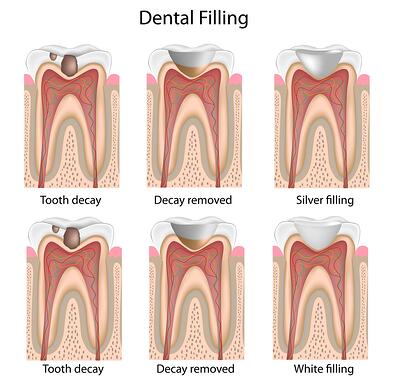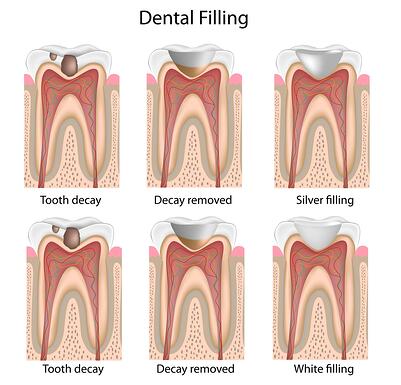Getting a cavity filled or a dental filling


Having a dental filling or cavity filled is typically a two-step process. The first step involves removal of decayed matter within the tooth that is caused by bacteria and creates cavities or, under other circumstances, the removal of tooth material from injuries to the mouth. The second step is the dentist applying dental material where the portion of tooth was removed so the patient is able to fully use their tooth again.
What is a Dental Filling?
There are some situations where the tooth has too much decay and a crown is required which fits over the tooth. This method is referred to indirect restoration. Under most circumstances, though, dental fillings will take place within the mouth and it is referred to as direct restoration. Dental fillings, on their own, do not need bridges, molds, or crowns.
Patients dread the first part of the dental filling – but they shouldn’t. Modern dentistry makes the procedure quick and painless. In order to get rid of the decaying part of the tooth, it is necessary for the dentist to drill into the patient's tooth. A numbing agent is used on the patient to numb the area being drilled, patients may feel a vibration.
Sedation dentistry is an alternative method that some anxious patients are using as a way of reducing anxiety during dental procedures. While certain medications are in use, patients are put into what is referred to as sedation where they are still conscious. The benefit of this method is the patient will have no memory of the procedure. Sedation dentistry is typically not covered by dental insurance and is typically a more expensive alternative.
Filling the tooth is the second half of the procedure. There are different materials that are used. It is common for US dentists to use polymer resins, as well as dental amalgam. Dental amalgam is comprised of metal mixed with mercury. There is some concern about mercury being placed into the mouth and this remains a matter of debate because some is leeched from the filling and ingested. The composite resin material is tooth colored (rather than silver) and cannot be seen inside the mouth. The resin material is stronger and is less likely to expand and contract (this expansion and contraction of silver fillings can cause the tooth to crack or allow bacteria to get under the filling)
How Much Do Dental Fillings Cost?
A typical dental filling's cost for someone who does not have dental insurance is dependent upon what type of filling is chosen (white composite or silver amalgam). According to most dentists, an amalgam filling will typically cost around $75-$200.00, but a white composite filling could cost from $100-$300.00 each.
What Can Patients Expect After Dental Fillings?
Once the numbing agent wears off following the dental filling, there are some patients reporting they are feeling mild discomfort. This discomfort could actually be from the injection site, rather than from the actual dental filling procedure. There are usually no restrictions after the numbing agent wears off.
Even though the thought of having dental fillings completed causes anxiety, it is not as invasive as many patients believe. While some drilling is involved, the actual procedure does not take too long. Sedation dentistry is one method that will help patients feel relief with their anxiety symptoms surrounding the entire procedure but is usually unnecessary.


